Physical Address
304 North Cardinal St.
Dorchester Center, MA 02124
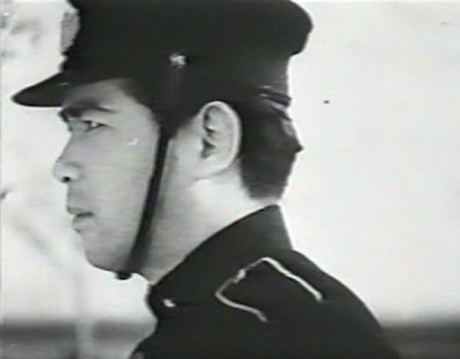
(Continue from Page 1)
On October 6, 1932, a group of three armed robbers wearing khaki coats entered the Ōmori branch of the Kawasaki Daihyaku bank and made off with the very substantial sum of 32,000 yen. The gang, bizarrely, were Communist Party members. Their leader, Ōtsuka Yūshō, desperate for funds to keep the organization going, carried out the crime despite the fact that the Japanese Communist Party (JCP) Central Committee had not approved it, and all but one of the committee’s members were completely in the dark about the plan.
The JCP, founded in 1922, had been outlawed, along with Socialists and other radicals, since the passage in 1925 of the Peace Preservation Law. This law went into effect even before the militantly anti-Communist Hirohito (Showa) became Emperor in 1926. Under the law, the police had the right to question and/or arrest not only active Communists and socialists, but leftist sympathizers as well… people much like Uchida Tomu himself. The so-called March 15th Incident of 1928, in which over 1600 people were arrested for real or suspected ties to Leftist movements, had demonstrated that the government was serious when it came to enforcing this legislation.
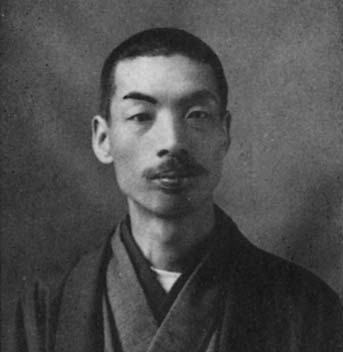
Ōtsuka, the brother-in-law of the prominent Marxist economist Kawakami Hajime (who would later translate Marx’ Capital into Japanese), was initially able to escape arrest because he had put Kawakami’s young daughter, Yoshiko, in the getaway car, thus diverting police suspicion. A number of other robberies were soon carried out, but later in the month, all those involved were arrested.
As Wikipedia describes the aftermath, “the robbery badly discredited the [Communist] Party in the eyes of the public. The government took full advantage of the incident and subsequent trial to portray [the Communists] as a nest of gangsters, leading to the destruction of the Party.” This is significant because, with the Communists out of the way, there remained no organized political movement in Japan to resist the rise of Fascism.
The film’s script was based on a recent play called “The Ōmori Bank Robbery.” But since Police Officer was released only a little over a year after this sensational incident – and because bank robberies were not exactly commonplace occurrences in rigidly conservative prewar Japan – even audiences unaware of the source play would automatically assume that the fictional robbers in the movie were Communists, similarly driven to steal to finance their activities, though the thieves’ political orientation is never stated explicitly.
“The mission of a police officer is to guard the peace of the nation and the serenity of society…” – Japanese police officer’s code (quoted in the film)
This is not only Uchida’s first major surviving film, but the first in which Uchida becomes Uchida, a filmmaker with whom it is possible to become completely obsessed. Although the picture was made during what was then, in the West, the early sound era, in Japan this was still, as noted in my review of Sweat, the late silent era, and the film displays in spades the visual excitement and expressiveness we associate with the twilight of the silent screen: the age of Battleship Potemkin and Metropolis and Sunrise. Though the movie has a number of significant flaws, it includes some complex and viscerally exciting scenes that make it easily comparable to those exalted masterworks.
And God, how this movie moves! Early in the film, as Tetsuo’s car departs after his first encounter on the highway with his old school chum Itami, a police motorcycle, approaching from the opposite direction, brings in the Chief of Police. The Chief stops briefly to ask Itami and the other officers if they’ve seen any sign of the master criminal. When they tell him they haven’t, the Chief’s cycle turns around and speeds back the way it had come, and Uchida’s camera – mounted on a car or other vehicle – unexpectedly follows close behind it, past another checkpoint and right up to the entrance to police headquarters. Then we’re immediately inside the headquarters itself, and we follow the impatient Chief as he rushes headlong, through a long phalanx of policemen standing at attention, to his private office, where he picks up a telephone.
This entire sequence takes less than a minute-and-a-half of screen time. Yet it’s enough to convey what to a 1933 Japanese audience must have been a sense of irresistible energy and almost chaotic speed – the essence of modernity. The short scene is impressive even now, nearly a century later.
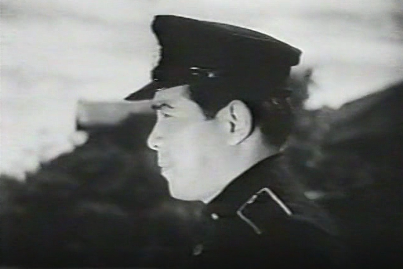
The scholar David Bordwell, in his classic book on Ozu, has called this highly extroverted visual approach the “calligraphic” style.1 The interesting thing about its use here is that it was originally employed mostly in period swordfight (chambara) films. Uchida’s contemporary and friend, Itō Daisuke, had employed this dynamic style in works such as his acclaimed three-part saga A Diary of Chuji’s Travels (Chuji tabi nikki, 1927). But at this point, it was rare for the calligraphic style to be used in a movie with a contemporary setting. In this sense, then, Uchida was pioneering something very new.
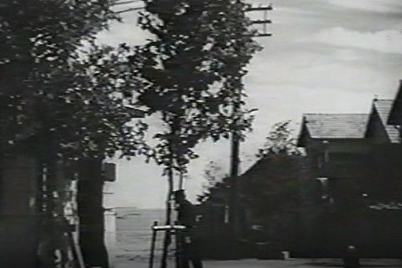
There are a number of interesting visual quirks here that recur in Uchida’s films of the prewar period. One of these is a propensity for moving a character abruptly from the extreme foreground to the extreme background of a shot. About fourteen minutes into the existing print of this movie, the hero is shown calmly but purposefully walking down the street, parallel to the picture plane, when he abruptly turns away from the camera to cross the road… but the camera doesn’t follow him. Instead, we see him move off into the far distance, his figure still in focus, until we realize that he’s reporting for duty at a police checkpoint. Only then does Uchida cut to a conventional medium shot of him entering the checkpoint. Uchida will do much the same thing, even more dramatically, six years later in Earth.
A few scenes later in the film, Uchida reverses the character’s movement when Itami leaves the checkpoint and moves from the background to the extreme foreground of the shot, to go stand guard (for reasons that are never made clear) beneath a train underpass at dusk. All this virtuosity may seem quite pointless until we realize that Uchida is seeking to dramatize the tense yet tedious waiting that’s part of a policeman’s normal routine, but to do so in a visually untedious way.

Near the end of the stunning night bank robbery scene, when Itami has disarmed and is handcuffing one of the robbers, both he and the criminal are very out of focus. It would seem that the director or his cinematographer has made an error… until several policemen on motorcycles suddenly swoop in to help Itami, with the first motorcycle entering the extreme foreground of the shot… in perfect focus.
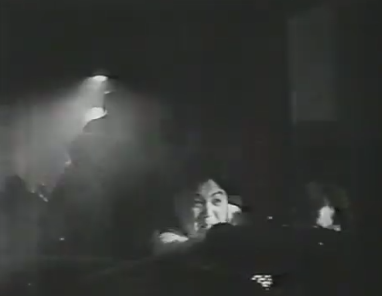
In the finest scene in the film – the police force’s attack on the robber’s hideout and subsequent chase – all the tension that has been building up throughout the movie seems to explode. The visuals are a wild blur of incredibly rapid movement, shadows and flashing lights. At one point, Itami and Tetsuo are seen running behind some kind of latticework, and the images of the men become uncannily abstract. (The cinematography by Aisaka Sōichi – whose first film this was – is particularly stunning here.) Throughout this scene, it’s very hard to tell, even after multiple viewings, exactly what’s going on, but the visuals are so dynamic that this scarcely matters. I really don’t think Murnau, Eisenstein or even Lang could have handled this climax more vividly or more dramatically.
Some who have written about this film have stated, or at least implied, that the work is merely a dazzling exercise in style tied to a tired, even hackneyed plot, like a creaky old Warner Brothers melodrama in a dazzling Japanese setting. I disagree. Yes, there are quite a few Hollywood films about childhood friends, one of whom grows up to be an outlaw and the other a respectable pillar of the established order (cop, doctor, priest, or what-have-you). But Uchida’s Asian variation on this theme is original and fascinating.

The situation is genuinely moving because the bond between the two men – which has strong sexual overtones – is profound and believable. So it’s completely credible that the hero fails to realize until late in the movie what we, the audience, have understood almost from the first: that his best friend Tetsuo is, in fact, the criminal he’s seeking. True friendship, like true love, can be stone blind.
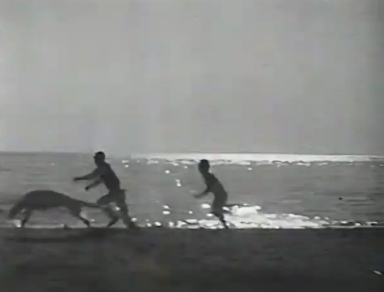
Whereas a Hollywood picture would establish with a few brief lines of dialogue that the two male characters are old friends, and then get on with the plot, Uchida, in a very Japanese way, takes the necessary time to convey how very much this relationship means to both men. In a bar, Tetsuo and the off-duty Itami reminisce about their high school days, when they avidly read and discussed German Romantic poetry. (I can’t seem to recall a Warner Brothers movie in which Jimmy Cagney and Pat O’Brien, say, talk about how much they really love the poetry of Novalis.) Then, during a beautiful flashback sequence – partially shot, apparently, with a handheld camera – the two are shown, as students, engaging in various youthful exploits, including playing rugby and running on a beach with a huge Afghan hound dashing ahead of them. (For some strange reason, these flashbacks don’t seem as embarrassing as is usually the case when adult actors try to play young people.)
But Tetsuo has a secret agenda, and he exploits this relationship to find out how much the police know about his gang. The hapless Itami, as a result, naively reveals to his friend how frustrated the police are with their investigation. But Tetsuo’s inquisitiveness inadvertently breaks the nostalgic vibe between them, setting up the movie’s second act, in which the policeman, his beloved sergeant having been wounded in the bank robbery, will take matters into his own hands to try to solve the crime.
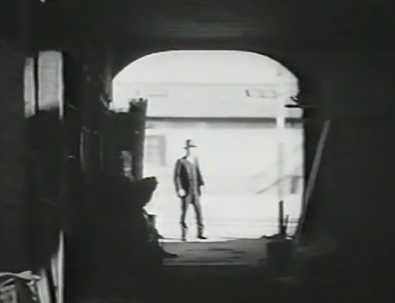
This next section is one of the most visually interesting of the film. Itami suddenly realizes he’s being followed in the street. He then turns the tables on his pursuer (who is one of Tetsuo’s gang) and begins chasing him through a fascinating labyrinth of very realistic-looking alleyways – which, as the blogger for Japanonfilm points out, may well have been real-life alleys, rather than studio sets. Uchida brilliantly exploits the sinister geometry of the city, with its high rises, elevated trains and dark, narrow spaces, and thus fascinatingly subverts, consciously or not, his protagonists’ role, making him seem more like a mouse in a maze than a hero.

Uchida is also sensitive to the surrealism of the modern city of his day. In one shot, Itami’s trench-coated pursuer is seen walking away, while in the background, rather than cars passing, we see a farmer on foot, leading an ox pulling a cart laden with what appear to be bags of rice. For me at least, this is a nice (unconscious) foreshadowing of Uchida’s 1939 masterwork about rice farmers: Earth.
The penultimate confrontation between Tetsuo and Itami occurs after the latter has forced Tetsuo, who’s desperate to get out of the country that night, to agree to have tea with him in a bar at the Ginza. When Tetsuo then impulsively offers Itami his fancy lighter as a gift and the policeman, careful not to put his own fingerprints on it, wraps it in a handkerchief and stows it away, Tetsuo realizes, thunderstruck, that his hidden fear that Itami suspects his guilt is justified.
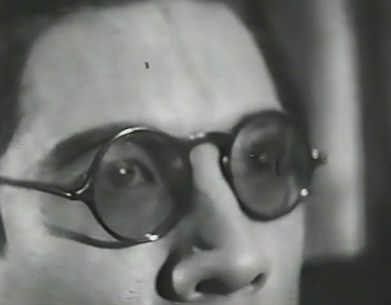
His look of helpless horror, seen in extreme close-up, is memorable – and strangely moving. Despite the fact that Tetsuo, as a criminal and a Communist, is revealed as a double enemy of the State, Uchida can’t help but present him sympathetically. Intentionally or not, Uchida, himself a left-liberal, presented a realistic portrayal of the anti-Fascist Left in Japan just prior to the movement’s total self-destruction: its isolation, its terror, its despair and, above all, its utter loneliness. Though Kosugi Isamu as Itami is excellent, Nakano Eiji’s ambiguous, nuanced and compelling performance as Tetsuo – a classic noir character – is the best in the film.
A huge difference between this movie and a typical Hollywood crime melodrama of any era is its emphasis on the redemption rather than the punishment of the criminal. As I pointed out in my article about Ozu’s silent crime films, made during this same period, those movies stressed the reintegration of the outlaw into the social order. In similar fashion, at the fadeout, Itami offers his captured friend an embrace (with clear homoerotic overtones) to signal the State’s mercy towards its “lost sheep.”
The film’s depiction of such forbearance on the part of the forces of law and order was far from realistic. During the early 1930s, quite a few of the remaining hardcore radicals in Japan – Communist and Socialist parties had been quite popular during the earlier Taisho era – were either openly murdered or disappeared into the prison system, never to be seen again. But the majority of Leftist intellectuals, particularly those prominent in high-profile cultural spheres like the film industry, underwent what was known as tenkō (reorientation), a process of conversion to the State’s right-wing agenda that occurred almost totally without the use of force. For the vast majority of these intellectuals – including, sadly, Uchida himself – this gentler strategy would work just fine.2
(Continued on Page 3)
[…] Police Officer (Keisatsukan, 警察官), 1933 […]
[…] Sakaba; たそがれ酒場), 1955A Bloody Spear at Mount Fuji (Chiyari Fuji; 血槍富士), 1955Police Officer (Keisatsukan, 警察官), 1933The Mad Fox (Koiya koi nasuna koi; 恋や恋なすな恋), […]
[…] Fuji (Chiyari Fuji; 血槍富士), 1955Twilight Saloon (Tasogare Sakaba; たそがれ酒場), 1955Police Officer (Keisatsukan, 警察官), 1933The Mad Fox (Koiya koi nasuna koi; 恋や恋なすな恋), […]
[…] Bloody Spear at Mount Fuji (Chiyari Fuji; 血槍富士), 1955Police Officer (Keisatsukan, 警察官), 1933Twilight Saloon (Tasogare Sakaba; たそがれ酒場), 1955The Mad Fox (Koiya koi nasuna koi; […]
[…] the exception of Police Officer (Keisatsukan, 1933), Sweat, a comedy he released in 1929, is the only complete, surviving silent […]
[…] on the above description, this movie would seem to take the ideology of Police Officer into a 19th Century narrative, with a stronger pro-government emphasis. Despite its apparent […]
[…] Police Officer (Keisatsukan, 警察官), 1933A Bloody Spear at Mount Fuji (Chiyari Fuji; 血槍富士), 1955Twilight Saloon (Tasogare Sakaba; たそがれ酒場), 1955Chikamatsu’s Love in Osaka (Naniwa no koi no monogatari; 浪花の恋の物語), 1959 […]